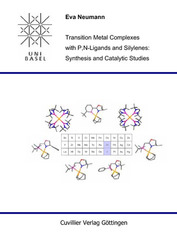| Fachbereiche | |
|---|---|
| Buchreihen (96) |
1377
|
| Nachhaltigkeit |
3
|
| Gesundheitswesen |
1
|
| Geisteswissenschaften |
2361
|
| Naturwissenschaften |
5403
|
| Mathematik | 229 |
| Informatik | 318 |
| Physik | 979 |
| Chemie | 1362 |
| Geowissenschaften | 131 |
| Humanmedizin | 243 |
| Zahn-, Mund- und Kieferheilkunde | 10 |
| Veterinärmedizin | 108 |
| Pharmazie | 147 |
| Biologie | 835 |
| Biochemie, Molekularbiologie, Gentechnologie | 121 |
| Biophysik | 25 |
| Ernährungs- und Haushaltswissenschaften | 45 |
| Land- und Agrarwissenschaften | 1004 |
| Forstwissenschaften | 201 |
| Gartenbauwissenschaft | 20 |
| Umweltforschung, Ökologie und Landespflege | 148 |
| Ingenieurwissenschaften |
1788
|
| Allgemein |
97
|
|
Leitlinien Unfallchirurgie
5. Auflage bestellen |
|
Erweiterte Suche
Transition Metal Complexes with P,N-Ligands and Silylenes: Synthesis and Catalytic Studies
Eva Neumann (Autor)Vorschau
Inhaltsverzeichnis, Datei (49 KB)
Leseprobe, Datei (120 KB)
The term ligand [latin, ligare = bind] has its origin in coordination chemistry. It denotes a molecule that is able to bind to a metal center in most cases via one or several free electron pairs.1 Ligands can be described by the number of electron-pair donor atoms as monodentate, bidentate, tridentate etc. ligands. The latter are also called chelating ligands [greek, chele = (crab’s) claw]. A typical classification of ligands is according to their electronic properties. They serve either as a σ-donating, σ-donating/π-accepting, or σ,π-donating/π-accepting ligands.2 A more practical, often encountered approach is the classification of ligands according to their donor atoms, especially when larger molecules and molecules containing heteroatoms are regarded (compare 1.2). Coordination chemistry was already established in the 19th century. In 1893 Alfred Werner suggested an octahedral arrangement of ligands coordinated to a central metal ion for many compounds. This explained, for example, the appearance and reactivity of four different cobalt(III) complexes (Figure 1.1), when CoCl2 is dissolved in aqueous ammonia and then oxidized by air to the +3 oxidation state. The formulas of these complexes can be written as depicted in Figure 1.1. Werner’s work was rewarded with the Nobel prize in 1913.3
| ISBN-13 (Printausgabe) | 3865378013 |
| ISBN-13 (Printausgabe) | 9783865378019 |
| ISBN-13 (E-Book) | 9783736918016 |
| Sprache | Englisch |
| Seitenanzahl | 244 |
| Auflage | 1 |
| Band | 0 |
| Erscheinungsort | Göttingen |
| Promotionsort | Basel |
| Erscheinungsdatum | 15.02.2006 |
| Allgemeine Einordnung | Dissertation |
| Fachbereiche |
Chemie
|








